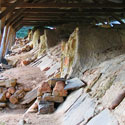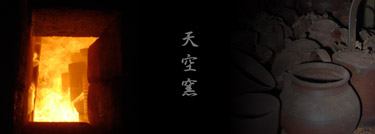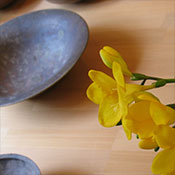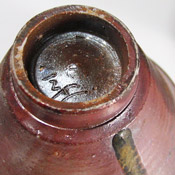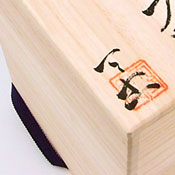Tamba is known as one of the six ancient pottery centers in Japan, and kilns have been fired there as far back as the late Heian period (794-1185). Early in its history, Tamba-yaki (Tamba ware) was fired in rudimentary kilns and mostly for the production of dailyware for the local community. In the late 16th century, the more advanced noborigama climbing kilns began to flourish, and grand, multi-chambered kilns would come to stretch up Tamba's surrounding hillside.
As Tamba-yaki became more diverse and more refined, the attention and admiration from Kyoto's noble class began to grow. Soon Tamba would produce pots for feudal lords, saké flasks for imperial courtesans, and bowls for tea masters, like the legendary Kobori Enshū, who found the rustic tenor of Tamba-yaki well attuned to the aesthetics of chanoyu tea ceremony.
Today, ceramic artist Nagai Ken fires his own modest noborigama not far from where the ancient kilns still stand. His unique rendition of Tamba-yaki, however, melds two artistic genres: wood-fired pottery and cast iron ware for tea.
View Bio
1959 |
Born in Yubara, Okayama Pref. |
1983 |
Graduates from Tsukuba University |
1986 |
Enters Kyoto School for Ceramic Arts Training |
1987 |
Apprentices at Kōzan-gama (Kōzan Kiln), Echizen Pref. |
1990 |
Moves to Tachikui City, Hyōgo Pref. |
1991 |
Establishes own kiln, Tenkū-gama (Tenkū Kiln), and begins concentrating solely on yakishimé unglazed stoneware. |
1995 |
Builds own wood-burning noborigama climbing kiln on the grounds of Tenkū-gama. |
1999 |
Holds solo exhibition at Omio Gallery, Paris |
2000 |
Holds annual exhibitions at Gallery Is'Sue, Kyoto |
2007 |
Works featured in The Story of Tea by Mary Lou & Robert J. Heiss |
2013 |
Relocates Tenkū-gama to Okayama Pref. |
2014 |
Solo exhibition, Ginya Gallery, Hyōgo Pref |
2015 |
Icchō Gallery, Tokyo |



